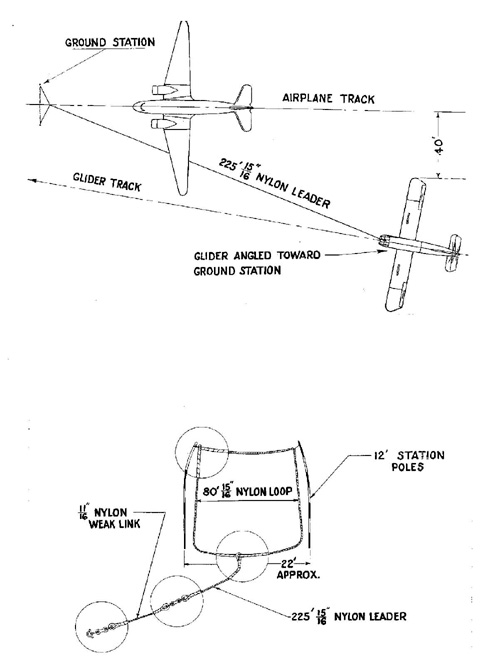
WWII Glider “Snatched” From Field on Everett Hopkins Farm
Compiled by Waldo Sherril Steen, 5/31/2008
The, June 29, 1944 issue of the Iberia Sentinel had an article on the front page about a WWII glider that broke loose from the tow plane and landed on the Everett Hopkins Farm on Friday, Jun 23, 1944. I was 8 years old at the time and witnessed the exciting retrieval on June 24, 1944.
Garrett Condra, 10 years old at the time, said he counted 44, C-47 tow planes and gliders in the formation that flew over on Friday. Garret witnessed the glider break loose from the C-47, tow plane and knew that it had landed someplace west of Iberia. Berry Blankenship, 12 years old at the time, was helping put up hay on the Bob Nixdorf farm and saw that the glider landed on his Uncle Everett’s farm.
The Google Earth picture of the area west of Iberia shows that the ½ mile long field on the Everett Hopkins farm is easily spotted from the air. In fact, it is more prominent than Eads Airport that lies about 2 miles east of the Hopkins field. As soon as the tow rope broke, the glider pilot simply picked the best alternative in sight. He made a wise decision.

The field is presently owned by Charles Pemberton. The picture below shows the field as it appears today from the glider pilots viewpoint. Jimmy Pemberton’s house is in the background.


JUNE 29, 1944
Excerpted from The Iberia Sentinel
BIG EXCITEMENT ON THE EVERETT HOPKINS FARM
Army Glider Grounded on Friday Picked up by Tow Plane Saturday Morning:
Large Crowd Assembled to Witness the Event
The people of Iberia and vicinity were treated to a thrill last Saturday (6/24/1944) morning when a glider which broke loose from a tow plane and landed in a pasture field on the Everett Hopkins farm two miles west of Iberia at 10:30 a.m. Friday morning was picked up by another plane.
A convoy of 45 planes or more towing gliders, some of them carrying jeeps and crews, were enroute from the Sedalia Air Base to the Vichy Air Port in Maries County when the glider broke loose from its tow plane. The glider was manned by two men—a pilot and copilot—and made the landing safely without damage to the craft or injury to the crew.
The grounded glider remained on the field until it was picked up Saturday morning by a tow plane, and this was when the exciting climax of the event came. It is estimated that approximately 300 people from town and the adjacent communities were present to witness the pick-up.
The tow plane in its action to pick up the glider, first made a test flight over the grounded craft to get its bearings and the second time, flying at a height of around 300 feet, threw out the tow line, picked it up and flew away with it as gracefully as a bird on wings. Preparatory to the pick-up, two poles were erected and anchored together at the top by means of a rope attached to the glider. This rope was caught by a large hook at the end of the towing cable, 300 feet in length. These towing cables are made of nylon and are said to cost $1.00 per foot. The one which broke loose the day before and lost on the field was recovered by Charles Haus who lives near the Hopkins farm.
The glider was snatched from the field by a C-47 on Saturday, June 24, 1944. Technical details of “the snatch” is described by Randolph J. Hils in “The Glider Squadron.” The pickup hook is attached to1050 feet of 3/8" flexible steel cable and is wound around the drum in the pickup unit installed in the C-47. The cable pay out is resisted by a set of multiple disk brakes which gradually and smoothly accelerates the glider to the speed of the tow plane. The glider usually ends its acceleration period in seven or eight seconds and 600 or 700 feet behind the plane. The pick-up unit is equipped with a motor to wind in the cable when the occasion requires.
Following is a diagram of what the 300 witnesses saw being erected prior to the successful retrieval of the glider. My father, Waldo A. Steen explained to his children (Carol, Geraldine and Sherril) that the nylon rope would stretch to absorb the shook of accelerating the glider from 0 to 150 mph. Berry Blankenship, Garrett Condra, Kenneth and Robert Pemberton all heard the same explanation while waiting for the exciting “snatch.” Apparently no one at the scene knew that the C-47 tow plane was equipped with a special “snatch” unit that could smoothly accelerate the glider to 150 mph in about 7 seconds. The “snatch” units had only become available in sufficient numbers to train the aircrews in January 1944.

P.O. Box 57
Tuscumbia, MO 65082
(573)-369-3500
http://www.MillerCountyMuseum.org
© 2007 - Miller County Historical Society